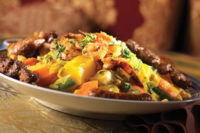Finding Sweet Success with Desserts






With desserts growing in popularity, the category is ripe for growth and innovation. Many operators are taking note. Restaurants across the industry are rolling out creative desserts to take advantage of consumers’ cravings for sweets. Yet, they are hardly taking the same, unified approach to enhance their dessert offerings. Instead, they are capitalizing on a number of distinct and simultaneous trends. Some of the dessert trends visible in 2011 carried over from 2010, but there are fresh and new examples to support them, with new brands getting in on the action. Technomic has also identified some new trends that have taken shape across the dessert category starting this year, proving the dessert segment continues to evolve, expand and entice.
Nostalgic, Comforting Ingredients
Technomic research has consistently shown that when the economy is sour, consumers gravitate toward tried-and-true foods that satisfy and soothe. Until recently, the comfort foods trend was restricted mainly to center-of-the-plate offerings and appetizers, as evidenced by the spike in the number of restaurants adding meatloaf, chicken pot pie, pot roast, chicken-and-waffle dishes and the like to their menus over the last few years. As the trend proliferated, it was only a matter of time before comfort foods and ingredients crossed over into other menu categories and asserted themselves in new and unexpected ways. Enter desserts.
So far, in 2011, numerous restaurant brands have rolled out desserts incorporating nostalgic, comforting ingredients designed to call to mind the simple pleasures of days gone by. Some of the ingredients exemplifying this trend:
* Marshmallows--Marshmallows are complementing new desserts across the U.S. In Chicago, The Park Grill serves a Sweet Potato Chiffon with cayenne caramel and burnt whiskey marshmallow. National chain Bar Louie recently introduced its own spin on s’mores, Campfire Crunch, featuring crumbled graham crackers, chocolate pudding, chocolate sauce, marshmallow fluff and toasted marshmallows.
* Bacon--An unusual ingredient in desserts, bacon has been popping up on more menus. Earlier this year, national chain Good Times Burgers & Frozen Custard rolled out two new desserts, both featuring bacon. The chain’s Squealer Spoonbender is a blend of frozen custard, chocolate syrup, chocolate chips and bacon topped with whipped cream and more bits of bacon. The Junior Hog Sundae features frozen custard topped with hot fudge, whipped cream and bacon pieces.
* Waffles--Waffles have long had a place in the dessert category, as waffle cones for ice cream. However, lately the waffle itself--not the ice cream--has been taking center stage. Sweetwater Tavern offers a Warm Flourless Chocolate Waffle served with vanilla ice cream. And, independent concept Vie recently introduced a Brown Butter Waffle.
New Twists on Old Favorites
Many consumers are open to trying desserts featuring new ingredients and flavor profiles, as the above trend illustrates. After all, a bacon-infused, blended frozen treat is hardly a typical dessert; the fact that Good Times added it to its menu means it believes customers will sample it. Despite many consumers’ willingness to branch out and try new things, a sizeable number still want to see their old dessert favorites on the menu. These favorites include staples, like cookies, cakes and pies, according to Technomic research. An offshoot trend of comfort foods gaining momentum against the backdrop of a down economy is that consumers also gravitate toward the familiar.
As a result, chefs across the industry are revamping classic desserts, like sundaes, milkshakes, cookies and pies. They are increasingly switching old ingredients for new ingredients; pairing seemingly incongruent flavors; modifying preparation techniques; and changing an item’s presentation--all for the sake of putting a fresh spin on old favorites. A few examples of classic desserts that have been given a contemporary makeover:
* Key Lime Pie, featuring a crumbled almond-biscotti crust, served with raspberry sauce and whipped cream (Biaggi’s Ristorante Italiano).
* Egg Nog Crème Brûlée, served with cranberry shortbread cookies (Blue Water Grill).
* Pumpkin and Milk Chocolate Bread Pudding, featuring cinnamon gelato (Campiello).
* Wild Blueberry Cookies, a European-style, crispy cookie featuring wild blueberries (Champagne French Bakery Cafe).
* Peanut Butter Rice Pudding, with bananas, crispy wild rice, graham-cracker streusel, cocoa crumbs and roasted-banana sorbet (George’s California Modern).
* Green Tea Sundae, featuring vanilla tapioca and chocolate sorbet (Spice Market).
* Mango Crème Brûlée, with fresh mango garnish (Stir Crazy Fresh Asian Grill).
Ethnic Influences
Ethnic cuisines have been making their mark on the U.S. foodservice industry for years. Cuisine popularity comes in waves, with a handful of cuisines seen as “hot” at any given time. (The article titled “Hot Emerging Cuisines,” on page 53 of this magazine, takes a closer look at three of-the-moment cuisines--Mediterranean, Cuban and Indian.)
These cuisines are assuredly serving as inspiration for appetizers and entrees, and even drinks, to a lesser extent; however, they have yet to really penetrate the dessert category. Instead, other cuisines--namely, Mexican, Korean and Japanese--are presently taking the dessert category by storm. An increasing number of chefs are recognizing that ethnic flavors and ingredients represent a viable way to craft innovative and savory desserts. These desserts typically have bold and/or unusual flavor profiles that capture customers’ interest and serve as a point of differentiation for the restaurant. Here is a look at how three ethnic cuisines are influencing desserts:
* Mexican--The line between Mexican cuisine and American cuisine has been blurring for years; Mexican cuisine is not so much hot right now as it is enduringly popular. As a result, non-Mexican and Mexican restaurants alike are adding Mexican-inspired treats to their menus. Carolina Ale House just introduced Dessert Nachos. Yoshinoya Beef Bowl lists flan on its menu. And, Mountain Mike’s Pizza and Jack in the Box both serve churros.
* Korean--The dessert category has been abuzz the last few years with talk of Korean frozen yogurt, which is more tart than other types of frozen yogurt. First Pinkberry and South Korean import Red Mango got the tart-frozen-yogurt ball rolling; now other chains are following suit. Freshëns introduced tart frozen yogurt this year, and Yogurtland has expanded its line of tart flavors.
* Japanese--Thanks to the work of a handful of specialty concepts, Japanese-style cream puffs are picking up steam on menus. Emerging chain Beard’s Papa, a Japanese import, has been expanding across the U.S. and spreading the message that little cream puffs can pack a big flavor punch. Dessert menus are starting to reflect that. SushiSamba debuted a new dessert menu featuring what it calls Kyoto Cream Puffs. For its part, Todai offers cream puffs on its extensive dessert buffet.
Small Bites, Big Flavor
Cream puffs fit into another current dessert trend as well: mini-desserts. The mini-dessert trend evolved over time, along with the more general small plates phenomenon. The dessert category has proved conducive to the idea of providing customers with just a taste of their favorite--or altogether unfamiliar--sweet treats.
The reasons for the category’s conduciveness to small bites are manifold. First, mini-desserts appeal to health-conscious consumers who want to indulge a little, but not go overboard. Second, they appeal to consumers who want dessert, but who might be too full to order a full-size portion. Third, they appeal to budget-minded consumers who are trying to lower their check averages, but still want to eat dessert. In addition, many mini-desserts are served as part of sampler combos, or flights, which appeal to consumers who enjoy the social aspects of dining out. For instance, a trio of mini-parfaits is sure to encourage sharing, while simultaneously sparking a conversation about how the parfaits look and taste. It is no wonder more and more operators are rolling out their own bite-size treats. Some notable examples:
* Outside-In Cinnamon Bites, a limited-time, bite-size pastry filled with warm cream cheese and cinnamon (Arby’s).
* Bite Me, Mary’s!, bite-size chunks of brownies and bananas Foster, deep-fried and drizzled with chocolate and caramel (Hamburger Mary’s).
* Mash-Ups, customizable mini-desserts that mix housemade ice cream with one of the chain’s Brownie Lollies; choices include Chick-O-Stick, s’mores, raspberry or caramel macchiato ice cream and peanut-butter, dark-chocolate-raspberry, milk-chocolate or Junior Mints Brownie Lollies (Houlihan’s).
* Mini-Dessert Sampler, a collection of classic desserts served in individual-sized portions; offerings include tiramisu, crème brûlée, apple crostada, chocolate zuccotta cake and New York-style cheesecake (Maggiano’s Little Italy).
Push the Boundaries, Pull in Customers
The dessert category presents seemingly endless opportunities to operators, in terms of product innovation. Although dessert generally makes up the smallest portion of most restaurant menus, there is considerable consumer demand for new and innovative treats. Operators can answer this call for delectable desserts in a number of ways, but they can start by integrating old-school ingredients, reinterpreting the classics, drawing inspiration from ethnic cuisines and offering smaller portion sizes. For those who do, the payoff could be super sweet. pf
Looking for a reprint of this article?
From high-res PDFs to custom plaques, order your copy today!







